For a long time, everyone who was involved in photography sought to acquire a DSLR that dominated the photo industry. However, in 2008 there was a coup - mirrorless technology appeared, which constituted an alternative to the mirror one and quickly gained fans. In order to figure out why mirrorless cameras are so fond of buyers, the editors of the site "bestx.htgetrid.com/en/" have compiled a rating of the best mirrorless cameras.
Content
- 1 Cameras - what are they?
- 2 How to choose a camera?
- 3 Additional criteria
- 4 Rating of quality models for 2020
- 5 Tips: choosing the best
Cameras - what are they?
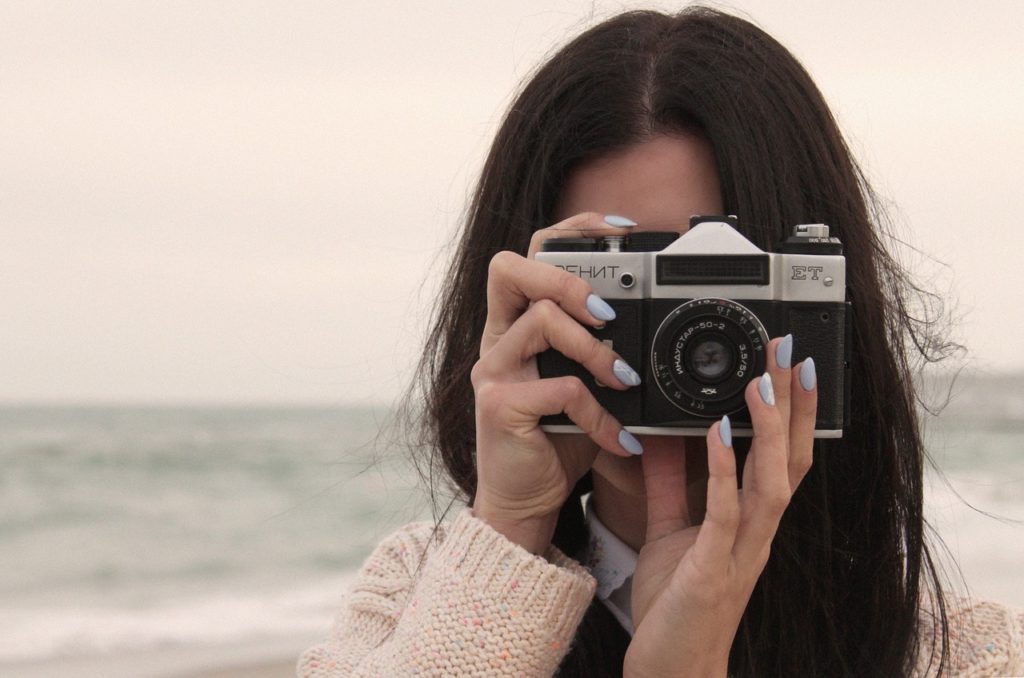
Photography technique is divided into the following types:
- Compact devices;
- SLR Cameras;
- Mirrorless models;
- Action cameras.
Compact devices

These include:
- Soap Dishes are inexpensive cameras. The simplest and most affordable among all that is on store shelves. They allow you to take a memorable frame for a family photo album and shoot in static is suitable, but it will not be possible to capture a moving object due to the fact that the matrix of such devices is very small. The advantage of such devices is their small size, thanks to which they can easily fit in women's handbags, and even technically inexperienced users will not have problems with their use. The disadvantage is the low quality of the shooting. The latest smartphones are capable of producing better photos;
- "Ultrazoom" (superzoom, hyperzuma) - differs from "soap boxes" in the lens, which allows you to photograph from a more distant distance. On such cameras, the zoom ratio is indicated, which means the ratio of the maximum and minimum focal lengths of the lens. The quality of the images taken with ultrazoom is also low, and the cost is higher than the price of the previous category. Ultrazoom is suitable for amateur travelers, those who want to capture the world around them, but there is no need for high quality;
- Professional - versatile photography equipment that combines the characteristics of several types of cameras. Equipped with a fairly good non-removable lens and a large matrix that provides high-quality images. The best models are equipped with high zoom optics, which allows you to photograph from afar. Due to its size, the device will not fit into a pocket, but at the same time the device does not look bulky and it is quite convenient to take it with you on trips. In terms of cost, professional equipment is significantly ahead of other compact devices.
SLR Cameras
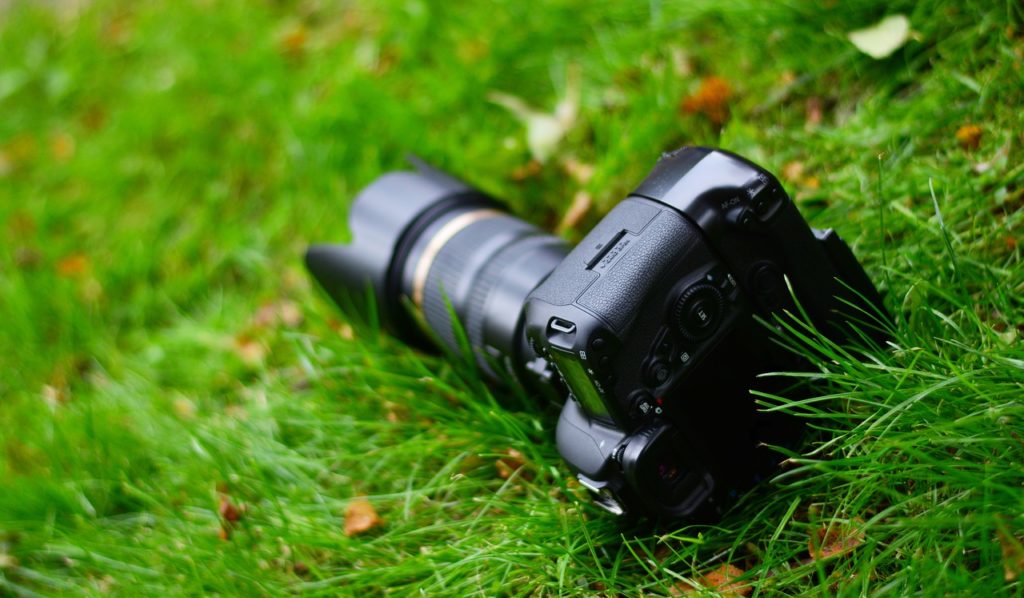
The name of the technique comes from its specific design features - the device is based on a mirror that refracts the future frame and sends it directly to the viewfinder. It is believed that it is because of this that photographs taken with a DSLR are of such high quality. In fact, the reason for the great images is the sensor size. DSLRs have a large one.
Another important point is removable optics, the varieties of which are many. Standard equipment for DSLR devices includes a camera body and a lens, which is called a kit kit or KIT - a good option for novice photographers.
Professionals prefer to buy a camera separately from lenses in order to be able to equip it according to their own needs, since different optics are needed for different purposes. This type of model is called Body or "carcass".
There are several disadvantages of mirror units - large dimensions and high cost. Not everyone can afford even devices from the middle price category.
Mirrorless cameras
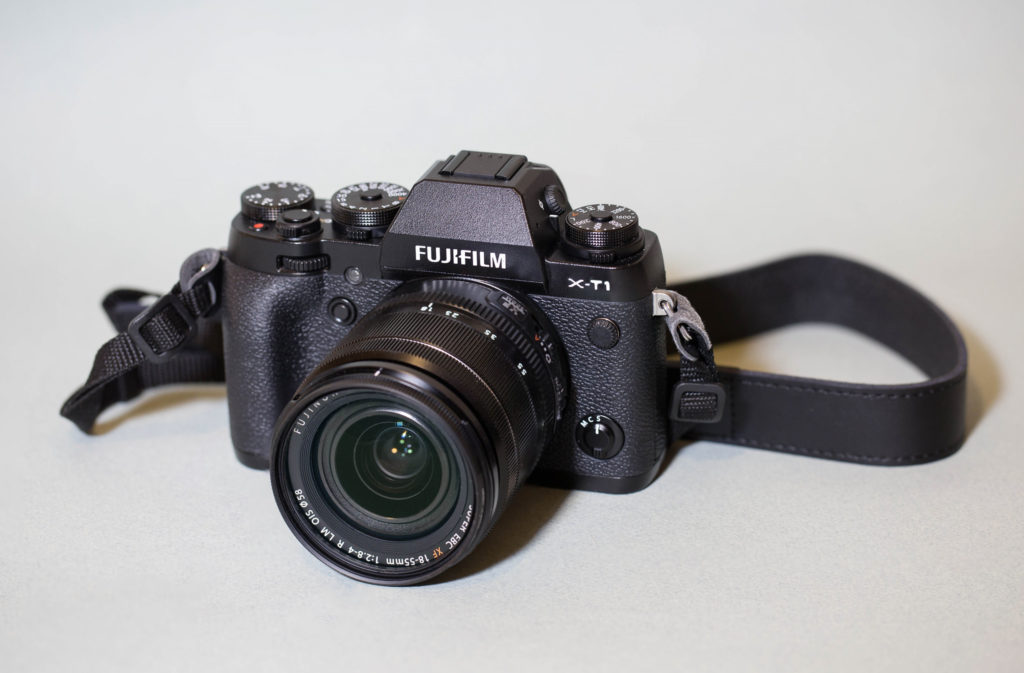
Interchangeable-lens system devices that have appeared on the market relatively recently. Also, like SLRs, they are characterized by a large matrix size, which provides high-quality images.
How is a mirrorless device different from a mirror?
The differences are as follows:
- Operating principle. The difference is that mirrorless devices use an electronic viewfinder, while SLRs use an optical one. The light flux, penetrating through the diaphragm, enters the sensor immediately. The image is processed by the processor, and then, in digital form, is displayed in the viewfinder or on the display;
- Dimensions. While DSLRs are the best option for studio shooting, it is best to take mirrorless equipment on a hike or for any long event. Mirrorless cameras are still far from pocket devices, but they are noticeably lighter in weight, and the case, in contrast to the mirror, is more compact due to the absence of a rising mirror and pentaprism;
- Design. DSLRs contain many mechanical elements, most of which are movable, which not only increase production costs, but also reduce the reliability of the device. Mirrorless devices are simplified as much as possible - not only the already mentioned mirrors and pentaprism are missing. There is no optical viewfinder and phase sensor, including.
A mirrorless camera is suitable for professionals as a lightweight option, as well as for those who intend to take photos on a regular basis.
Action cameras
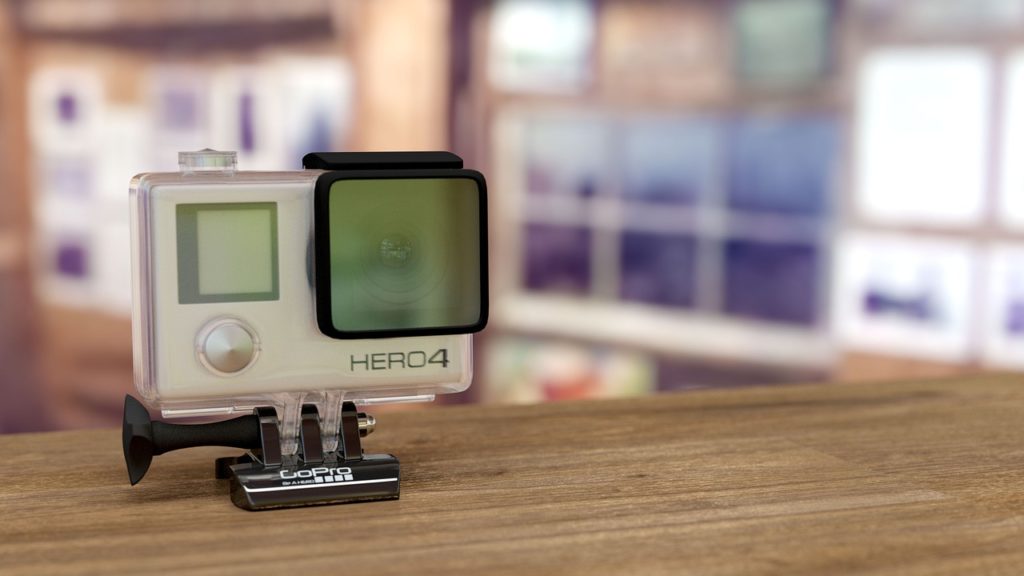
The technique, the name of which contains the whole essence of the device, is cameras that are used for filming and photographing during active actions (often associated with extreme conditions) - skydiving, bungee jumping, scuba diving, high-speed driving, ski slopes, and so on. Further.
Action cameras provide a high-quality picture, but in low light, all functions come to naught. At the same time, the price for such devices is very "biting".
Next, we will consider the main selection criteria that will help you navigate which camera is better to buy.
How to choose a camera?
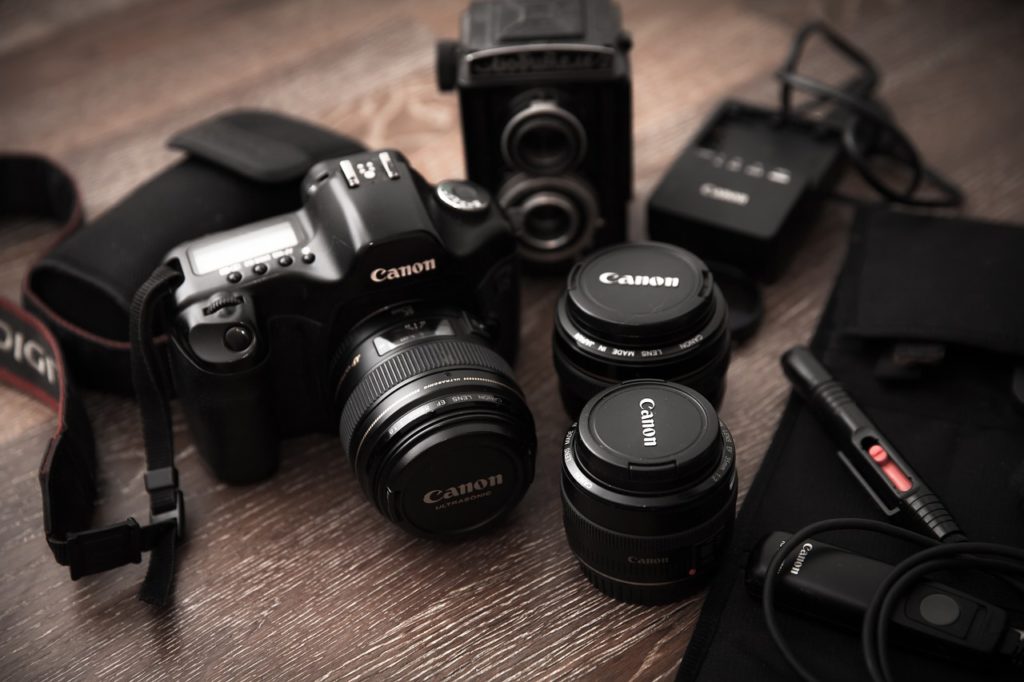
Competently approaching the choice of photographic equipment, you should pay attention to the following parameters.
Matrix
The matrix (or sensor) refers to the part of the device where the photo is formed. This is the basis of any camera and it is presented in the form of a microcircuit made of photodiodes that convert the light flux into electrical signals. The analog-to-digital element then converts the electrical signal to digital.
The size
The quality of the sensor is responsible for the potential of the device as a whole and it has many parameters, but the most important of them is its physical size. The larger the value of this element, the clearer and better the picture will be.
Matrix resolution
Resolution, that is, the number of megapixels of the matrix is also of great importance.Pixels (pixels) are light-sensitive elements that are located on the sensor, the more their number, the higher the quality of the images. Also, the size of a picture in which it can be reproduced without a noticeable decrease in quality also depends on the resolution.
A certain number of light elements are consumed for internal needs, and therefore the division of pixels into total megapixels and effective megapixels is accepted. The effective megapixels indicate the actual resolution.
Format and type
The maximum format that the sensor can have is a 35mm full frame. Due to the complex production process, as well as the high cost, full-frame sensors are installed only in expensive professional devices. Budget mirrorless models are most often equipped with Micro 4/3 Four Thirds sensors. The most common sensors found in mid-range models are the APS-C. In studio technology for professionals, a medium format view of the matrix is used.
Regarding the type of matrix, the following are used in modern cameras - CMOS, BSI CMOS, CD, X-Trans CMOS, Live MOS and EXR CMOS.
Crop factor
Crop factor is a value that determines the difference between the physical size of a photographic sensor and a traditional 35mm film frame. The crop factor is used to calculate the focal length when the lens is mounted on different models. That is, knowing the value of the crop factor, it is possible to determine the focal length of a particular lens and compare it with the characteristics of other models. For example, if a camera has a crop factor of 2, it means that the sensor is half the size of a 35 mm frame.
The crop factor can be calculated by dividing the diagonal length of a 35mm frame by the diagonal length of the sensor. You can also look at the instructions from the manufacturer, where the value of the crop factor should be indicated.
Color depth
The color of each pixel is encoded by a certain number of bits (elementary particles of information). In accordance with how many bits are spent on a color for each pixel, the encoding of a different number of colors is determined. As a consequence, color depth makes it possible to determine the limit on the number of colors and tints that can be reproduced in a picture.
For example, if the depth is 24 bit / pixel, then the color content of a potential picture will be approximately 16.8 million of all kinds of colors and shades.
Light sensitivity
Light sensitivity is the amount of light energy required to produce an image. It is characterized by a minimum and maximum value, measured in ISO units, and the higher the specified value, the higher the sensitivity. For example, shooting in low light conditions and high speed of movement of the subject requires increased parameters of the sensitivity of the matrix.
The operating range of the sensitivity is also important - its width provides more possibilities, since it is in this interval that the sensor is able to transmit an image with minimal interference and acceptable noise.
Viewfinder
There are four types of viewfinders - optical, electronic, mirror, and hybrid.
Optical is the most common and is a design of optical lenses, with the help of which the camera is aimed at the subject of photography and the boundaries of the future photo are determined. Disadvantages - the parallax effect, that is, the discrepancy between the image that is displayed in the viewfinder and the image that is visible in the lens. The photographer has no way of tracking the focusing accuracy.
Electronic is produced in the form of a small LCD-screen complete with a lens, which is mounted inside the device. The future frame is displayed on the screen of the viewfinder exactly in the form in which it is determined by the light-sensitive matrix, "seeing" through the optical system of the camera. The electronic viewfinder eliminates the possibility of parallax, and therefore the photographer can immediately determine all the shooting parameters.The main parameter of the electronic viewfinder is resolution. It means the number of pixels and the higher it is, the more detailed the image will be displayed on the screen. The main disadvantage of an electronic viewfinder is its high power consumption.
Mirror has the following principle of operation - the image falls on it directly through the lens using a folding mirror. Parallax is absent, and therefore the photographer is able to control key parameters, including focusing accuracy and depth of field.
The hybrid viewfinder combines the advantages of optical and electronic.
There are also models without a viewfinder, where a liquid crystal screen performs its function. It displays the image that enters the photosensitive matrix. The disadvantage is that it is difficult to see the image on the screen in bright light.
Screen type
The screen can be rotary or non-rotary, as well as touch or push-button.
In a pivoting design, both the screen itself and the rear panel of the device can be rotated separately. The rotation is carried out around its axis by 90 degrees or opens to the side, similar to video cameras.
The touch-sensitive, i.e., pressure-sensitive LCD display allows you to select the operating conditions of the device by touching the corresponding images on the screen. And the absence of buttons makes it possible to expand the display itself.
However, most models of devices are equipped with buttons located at the back of the screen for selecting settings.
Exposition
Excerpt
Exposure is the time period during which the shutter of the apparatus remains raised to take a picture. Has a maximum and minimum value. The exposure time determines how much light hits the photosensitive matrix, which in turn determines the correct exposure. For example, shooting at night requires a slow shutter speed. But for brightly lit objects, as well as for fixing moving objects, exposure is required at a minimum.
The exposure range is different for each model, as it depends on the technical capabilities of the camera. However, the wider it is, the more suitable the camera is for subject shooting.
F-number (F-number)
This parameter denotes the ratio of the focal length to the lens diameter, and determines the amount of light that appears on the photo sensor. Has a maximum and minimum value. The lower the F-number, the more light the optical system will let through and the better the image will be in low light conditions.
The maximum aperture value is set manually, the minimum is determined by the characteristics of the lens.
For zoom lenses, two f-number values are used - at the position when the focal length is at its minimum (wide angle) and at the position when the focal length is at its maximum (telephoto). The teleposition should be greater than the wide angle, and from these two numbers you can analyze how much light the optics lets in in different shooting modes (aperture).
Automatic exposure processing
There are two types of mode:
- Automatic processing with shutter priority - it makes it possible to set the required shutter speed, and the aperture value is set independently depending on the degree of illumination of the object being shot;
- Automatic processing with aperture priority - allows you to select the required aperture value, and the shutter speed is adjusted to the light.
Exposure compensation
Exposure compensation is called manual exposure compensation, relative to the parameters calculated by the camera in automatic mode. Metered in the same way as exposure in EV. Shifting the exposure by one step will double the amount of light entering the sensor. Positive shift - there is an increase in the aperture / shutter speed. Negative - similar decrease.
Exposure compensation is most often used in cases where the automatically calculated exposure produces an undesirable result. For example, when shooting brightly contrasting objects.
Exposure Bracketing
Refers to a still image mode in which each frame is captured with a different shutter speed and aperture value offset from each other. The result is a series of shots taken in different parameters, from which you can choose the best photo. Bracketing is used for photo shoots shot in difficult conditions when it is not possible to clearly determine the correct exposure.
Focusing
A special module is responsible for the focusing process, which focuses on those areas of the frame that are in the space covered by the linear focus points. The number of such points directly affects the accuracy of identifying the object on which you want to concentrate at the time of shooting.
Linear points are horizontally and vertically oriented, and the effectiveness of their use depends to a greater extent on the subject of photography - vertical orientation points focus well on objects with horizontal lines, and horizontal orientation points, on the contrary, with vertical ones.
Autofocus type
In modern models of cameras, passive autofocus is used, of which there are several types:
- Contrast - most often used in mirrorless cameras. The principle of operation is as follows - the processor of the device analyzes the current image on the matrix and shifts the lenses to one of the two sides. If after this manipulation the picture becomes more contrasting, then the movement of the lenses continues up to the point when the need for focusing is found. If the picture quality deteriorates, the lenses move in the opposite direction until the desired position is found. Contrast focusing is best for shooting in dark environments;
- Phase - it is most often used in DSLRs and for its operation special sensors are required, to which fragments of the light flux from different points of the frame are received using mirrors. After that, the sensors calculate at what distance the two luminous fluxes should be from each other to achieve an accurate picture. The advantages of phase detection autofocus are fast operation speed;
- Hybrid - combines the advantages of contrast and phase detection autofocus. It is embedded in both mirrorless and mirrorless devices.
In some models of cameras there is an emitter (backlight) built into the body of the device. It provides an additional light source for auto focus operation.
In addition to automatic technology, there is manual focusing, which allows you to more accurately focus on the subject, since the automatic does not always work correctly.
Face Focus
A function that detects the presence of a face in the frame, and then automatically sharpens it. Also, this function implies automatic exposure and will be useful for those who often photograph people against different backgrounds.
Memory and interfaces
The cameras use the following types of memory cards to store captured images:
- Compact Flash I / Compact Flash II is the most common type, is supported by many devices and has an optimal price / volume ratio. In models that support Compact Flash II, Compact Flash I can also be used;
- HC MMCPlus - large memory cards that can only be used with compatible devices;
- SDXC - a feature is a volume of up to 2 GB and a data exchange rate of up to 104 MB / s;
- Secure Digital / Secure Digital HC - SD limited to 4 GB. The SD expansion - SD HC has a capacity of 4GB to 32GB. Outwardly, they are very similar, however, SD HC can only be used with compatible technology;
- Smart Media are fragile and not practical, and therefore are gradually leaving the market;
- XQD - data transfer rate up to 125 MB / sec;
- microSD - super compact cards that are compatible with devices operating on T-Flash cards;
- microSDHC / microSDXC - most often used in compact cameras;
- xD-Picture are small, highly reliable and low in power consumption.
Interfaces
- Bluetooth - allows you to connect the camera to a PC and other devices using wireless technology;
- FireWire - also provides connection to a PC via the IEEE 1394 i.Link interface, which is distributed by Apple;
- HD video - a video output on a camera, which is usually used for viewing photos through a connection to a high-definition TV using a special cable or adapter;
- HDMI - used to transmit high-definition video images to equipment with the appropriate technical characteristics - HDTV standard TV;
- RS232 - COM port, which is practically not used in modern models of cameras due to low rates of information transfer;
- USB is by far the most common connection option, since almost all modern equipment supports USB. Some models have the ability to charge the battery from a computer via a USB cable;
- Wi-Fi - it can be used to transfer files to a PC, as well as print pictures on a printer that is also equipped with a Wi-Fi adapter;
- Audio - an output that allows you to connect photographic equipment to a device that reproduces sound;
- Video is a composite interface that is used to view information through a television.
Audio and video recording
The presence of the video recording function allows you to shoot small videos with the camera, as a rule, at a speed of 15-30 frames per second and a resolution of 320x240 / 640x480. The higher the resolution, the clearer and more detailed video you can get in the end. Soundtrack to the video is recorded if a microphone is built into the structure. The frame rate of the video is also important. At low rates, moving objects move as if in jerks. In order for this effect not to occur, a frequency of 24 to 30 frames per second is required. Some cameras are capable of shooting at 1000 frames, however, the higher this figure, the more memory is required to record video. Since the function is considered entertaining, it is rarely present in professional technology.
Video codec / video container
A codec means a method that allows you to compress video information, and a container means the ability to expand a video file. The type of container determines which programs will later be used to play the recorded recording. The codec type indicates in which format the information will be saved and its subsequent quality.
The video format can be:
- ASF - was developed by Microsoft, supports different codecs, and Windows Media player is suitable for playback;
- AVI is the most common extension standard, with picture and sound content;
- MOV - developed by Apple, QuickTime is used for viewing;
- MP4 - a multimedia container containing video and audio streams; MPEG-4 codecs are used for compression;
- MPEG VX - developed by Sony, used in the technique of this brand, and for playback, you will need to install the appropriate program on your PC.
Functionality and its capabilities
White balance is a function that makes it possible to compensate for color distortion caused by the characteristics of various light sources - sunlight, incandescent light bulb, fluorescent lamp, etc.
White is perceived as white in sunlight, but may be perceived differently in other conditions. White balance is used to correct color distortion and. In most digital cameras, white balance is automatically adjusted, without human intervention, adjusting the color sensitivity of the device. Due to this, the colors are reproduced relatively naturally, but the automatic program is not able to take into account all the nuances and in some models the manual option is provided. Other functions are preset white balance and manual setting.
Flash - is a lamp built into the body, which fires simultaneously with the opening of the shutter. The purpose of the flash is to illuminate the subject at the time of the photograph, which allows photographs to be taken in low light conditions. The built-in flash may not be available on some models designed for use with external lighting.
Stabilizer - Compensates for hand-shake when shooting or shake when walking for a clear, blur-free image.
All mechanical stabilization systems used today can be conditionally divided into two types. The first is realized by means of a movable element in the lens, the second - by means of a shift of the photosensitive sensor. Matrix shift stabilization is good in that it does not distort the image and does not affect the optical aperture, thereby allowing the use of any lenses. But a stabilizer with an active element is considered to be more effective, since it provides a high speed of operation.
Shooting modes
- Photo shooting speed - determines how fast the frame will be captured in the burst mode. This parameter refers to the shutter speed and the speed at which the system processes images. The higher it is, the more pictures of the object of interest the user will have time to take. It is important to remember that the quality of such photos will differ from those taken in standard mode. Some manufacturers provide the ability to adjust the parameters of quick photography, so that you can more accurately adjust the camera for specific tasks;
- Maximum burst of photos is how many shots can be taken in a burst and saved in the desired standard (JPEG or RAW). This value is limited by the functionality that characterizes the electronics of the device;
- Burst shooting is the ability of the device to take a certain number of shots in a row at a minimum interval. The more photos the device can take within one series, the more potential it has. This option is especially important if the task of the photographer includes the need to "catch" a dynamically moving object in the frame, for example, during sports or dance events;
- Timer - makes it possible to set the time after which the shutter will work, which is very convenient when you need to take a collective photo with the participation of the photographer himself;
- Time-laps - a mode, when activated, pictures are taken after a set time interval - from a couple of seconds to several tens of minutes. Time laps are used to achieve various goals, but the most common scenes are the blooming of a flower, the sun sinking beyond the horizon, etc.
Photo format
There are formats 16: 9, 3: 2, 4: 3.
The numbers indicate the ratio of the height of the frame to its width.
The 16: 9 aspect ratio matches widescreen monitors and TVs, and therefore photos taken at this size look best on widescreen devices.
3: 2 images are suitable for printing on standard photo paper.
4: 3 size is the screen format of a computer monitor. Suitable for viewing images on a PC as it makes the most of the available area.
Nutrition
Power is supplied by standard type elements (most often AA and AAA). Own batteries are used less often.
Standard ones are great because they are easy to replace when needed. The number of standard batteries may differ depending on the model, but usually the number is within four. With a smaller amount, the weight of the device decreases, but the total capacity of the batteries becomes too small, which affects the duration of autonomous operation.
Own batteries are lighter, more efficient and come with a charger, but they are difficult to replace. The large capacity battery allows you to take more photos before recharging is needed.Often, manufacturers indicate the battery capacity in the number of shots, which gives a clearer idea of the capabilities of the camera.
Some models provide a special input for connecting an external power supply, which is much more convenient when conducting studio sessions.
Additional criteria
To eliminate the possibility of error, when choosing, you should take into account such properties as:
- Matrix cleaning - models with a cleaning function are equipped with a special mechanism that removes dust deposited on the surface of the part. The cleaning function is realized by shaking the sensor slightly with ultrasound, which is generated when the device is turned on and off;
- A bayonet is a type of interchangeable optical system mount that determines which lenses can be used with the camera. The bottom line is that on devices with interchangeable lenses, you can install only those elements that are specifically designed for a particular model, since the mounts are different and each manufacturer has its own lens standard. If you already have a set of lenses when buying a camera, then it is best to choose exactly the model that will be compatible with them;
- Field of view is a characteristic of the viewfinder that does not always match the field of view of the lens, making up only 80% of it. Because of this, the photographer does not always see the entire captured image, but only a large part of it, which forces him to make a mental correction, taking into account that the resulting image will be slightly larger than the one displayed in the viewfinder.
Advantages and disadvantages
Advantages:
- Mirrorless design makes the device more compact;
- Lack of noise and vibration arising during photography with a SLR camera;
- Electronic viewfinder in the form of an LCD display;
- A small number of mechanical elements, which increases the reliability of the device;
- The cost is lower than that of a DSLR;
- According to buyers, the display that a mirrorless camera has is much more convenient to use than the viewfinder of a DSLR;
- There is an opportunity to view the pictures that were taken using custom filters and standard settings;
- Wide range of models.
Disadvantages:
- Screen restrictions on contrast and saturation levels;
- The picture is reproduced with a delay due to the speed of the processor;
- Bright light can cause reflections on the screen, making it difficult to view the captured photo;
- Fast battery drain.
Main technical characteristics
| room | Specifications | Recommendations |
|---|---|---|
| 1 | Body material | The camera body can be made of metal or plastic. The plastic material makes the camera light and cheaper, but the device is not resistant to mechanical damage. The metal body makes the camera more reliable, but the design is noticeably heavier and more expensive. In professional cameras, as a rule, a metal body is used. |
| 2 | Matrix resolution | The capabilities of modern cameras significantly exceed the required minimum and are improving every year. Today there are models with a resolution of 15-20 megapixels. However, the race for MP is not always a plus, since an increase in the resolution with a constant physical sensor size leads to a decrease in the pixel size, which in turn increases the noise level in the photo. |
| 3 | Crop factor | The best modern cameras have a crop factor of 1 (so called full frame). On the other end there are cameras with a crop factor of 5-6. |
| 4 | Color depth | For modern technology, the norm is a color depth of 24 bit per pixel. If you need maximum accuracy in rendering shades, you should choose a model with a depth of 30 bits per pixel. |
| 5 | line of sight | High quality cameras have a viewfinder field of 90-100%. |
| 6 | How much is | The average cost of a quality mirrorless camera is about 43,000 rubles. |
Rating of quality models for 2020
Sony Alpha ILCE-6000 Kit
Manufacturer: Sony (Japan)
Average price - 41,000 rubles.
A mirrorless camera with interchangeable optics and an electronic viewfinder, which supports interchangeable lenses of the Sony E mount. The number of effective pixels of the sensor (CMOS size 23.5x15.6 mm) is 24.3 million. Crop factor is 1.5.
White balance is set in automatic as well as manual mode, bracketing is present.
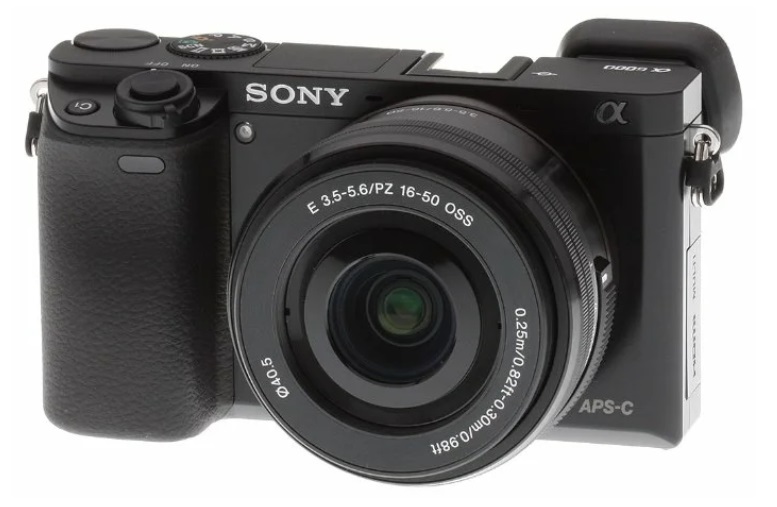
The technician takes photographs at a speed of eleven frames per second, saving images (JPEG and RAW) in 3: 2, 16: 9 formats. The viewfinder's field of view is one hundred percent. The three-inch liquid crystal display is equipped with a swivel mechanism. Hybrid autofocus.
All interfaces necessary for work are available - HDMI, USB 2.0, HD-video. There is also a connector for the remote control. Power is supplied by the light of its own battery, the capacity of which is enough for 360 shots in standard mode.
The functionality of the device allows you to record video of the AVCHD, MP4 standard. The limiting video resolution is 1920x1080 at 60 frames per second.
There is a digital zoom 4x.
Advantages:
- using the screen as a viewfinder;
- convenient menu;
- high image quality;
- supports many memory cards;
- allows you to record audio and video;
- with lens included;
- with sensor cleaning function;
- low crop factor;
- there are 3D and HDR modes;
- there is a built-in flash that suppresses red-eye;
- there is a timer;
- in the presence of a mount that allows you to install the equipment on a tripod;
- remote coordination, as well as control from a PC.
Disadvantages:
- there is no image stabilizer;
- no horizon;
- without touch screen.
Canon EOS M50 Kit
Manufacturer: Canon (Japan)
Average price - 54,000 rubles.
A mirrorless camera with a plastic body, interchangeable optics and an electronic viewfinder with a field of view of 100%. The device supports Canon EF-M mount and allows you to realize the most original creative ideas. The number of effective pixel CMOS sensor measuring 22.1x14.9 mm is 24.1 million. The crop factor is 1.6.
The color depth that the equipment is capable of transmitting reaches 42 bit. Setting the white balance can be entrusted to the automatic mode, and then the system will select the desired value itself, or manually adjust it from the list. The built-in flash range is up to 5 meters.

The camera captures the subject at a rate of ten frames per second and the maximum number of shots that can be taken in a burst is 33 shots in JPEG and 10 in RAW. Photos can be saved in one of these formats - 4: 3, 1: 1, 16: 9.
The 3-inch touchscreen LCD has a swivel mechanism for enhanced usability.
The contrast-type autofocus is equipped with a backlight, manual focus and face-to-face focus.
Supports the most common types of memory cards - SD, SDHC, SDXC.
USB 2.0, HDMI, Bluetooth, NFC interfaces increase the capabilities of photographic equipment, allowing you to perform all the manipulations necessary for a modern photographer. There is also a microphone output.
Power is supplied by one own battery with a capacity of 235 photos taken in standard mode.
The function of video recording with sound makes it possible to make small videos for home archives or for your own blog on the Web. Videos are recorded in MP4 standard. The video recording size limit is 4 GB, which is equivalent to a half-hour video.
Advantages:
- classic design;
- a light weight;
- lens included;
- low crop factor;
- with sensor cleaning function;
- with red-eye reduction function;
- with a timer;
- with Time-lapse mode;
- with orientation sensor;
- with bracketing;
- supports Wi-Fi;
- HD and НDR formats are available;
- there are mechanisms for securing the tripod.
Disadvantages:
- there is no stabilizer;
- the battery capacity is not accurately displayed on the screen;
- the display does not show information about the available memory card space.
Olympus Pen E-PL8 Kit
Manufacturer: Olympus (Japan)
The average price is 34,000 rubles.
An interesting mirrorless camera without a viewfinder, but with a metal body and interchangeable lenses for Micro 4/3 mount. The number of effective pixel sensor (CMOS size 17.3x13.0 mm) is 16.1 million. Crop factor is 2. The color depth is thirty-six bits and this is enough to create a colorful saturated picture.
White balance adjustment is set automatically, or you can intervene in this process and select the desired value manually from the list.
The camera is capable of shooting at eight frames per second and the number of shots that can be taken continuously is 20 in the RAW standard. Images are saved only in 4: 3 format.
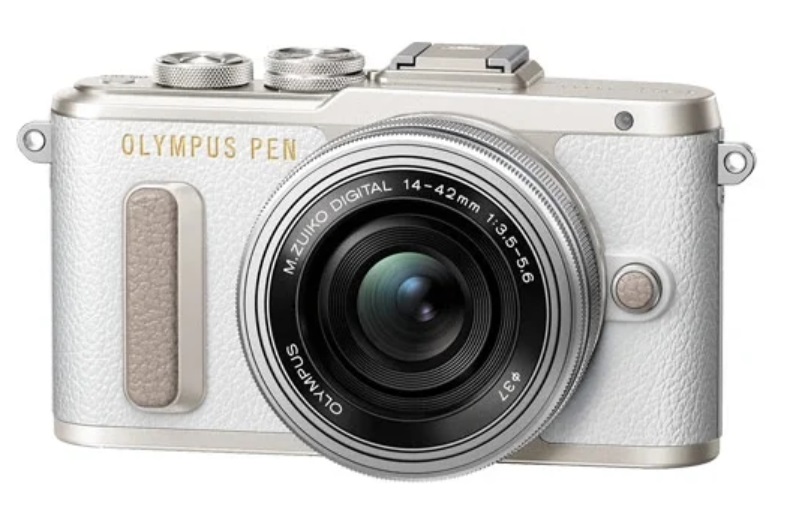
The 3-inch liquid crystal display has rotary mechanisms and is equipped with a sensor, which allows you to quickly set the desired modes.
Focusing is performed on 81 points, nine of which are cross-type.
Supports such types of memory cards as SD and its extensions - SDHC and SDXC.
Interfaces - USB 2.0 and HDMI. There is also an audio and video output, as well as a spot for a microphone. The camera is "powered" by its own battery (1).
The device is capable of recording videos in the AVI and MOV standard at a maximum rate of thirty frames per second.
Additional functionality includes a mount that allows you to mount photographic equipment on a tripod, as well as remote coordination and control from a PC.
Advantages:
- with lens included;
- with sensor cleaning;
- photography in 3D format;
- there is exposure bracketing;
- good optical image stabilization with sensor shift;
- timer;
- high level of customization;
- using the screen as a viewfinder;
- focus on the face;
- with JPEG + RAW recording mode;
- Wi-Fi is connected;
- you can record video, audio and sound comments.
Disadvantages:
- complex menu by default;
- there is no way to charge the device via the USB port;
- heavy;
- the flash is attached separately.
Panasonic DC-GX9 Body
Manufacturer: Panasonic (Japan)
Average price - 59,000 rubles.
Mirrorless electronic viewfinder and interchangeable Micro 4/3 mount lenses. The number of effective pixel sensor (Live MOS size 17.3x13.0 mm) is 20.3 million. Crop factor is 2.
The white balance is adjusted by the system independently, as well as manually from the available list.
The camera takes pictures at a speed of nine frames per second and the maximum number of burst photos is 140 in the JPEG standard and 29 in the RAW standard. Images are saved in one of the selected formats - 4: 3, 3: 2, 1: 1, 16: 9.
The 3-inch LCD screen is equipped with a touchscreen and swivel mechanism and can be used as a viewfinder.
Contrast-type autofocus focuses on 49 points.
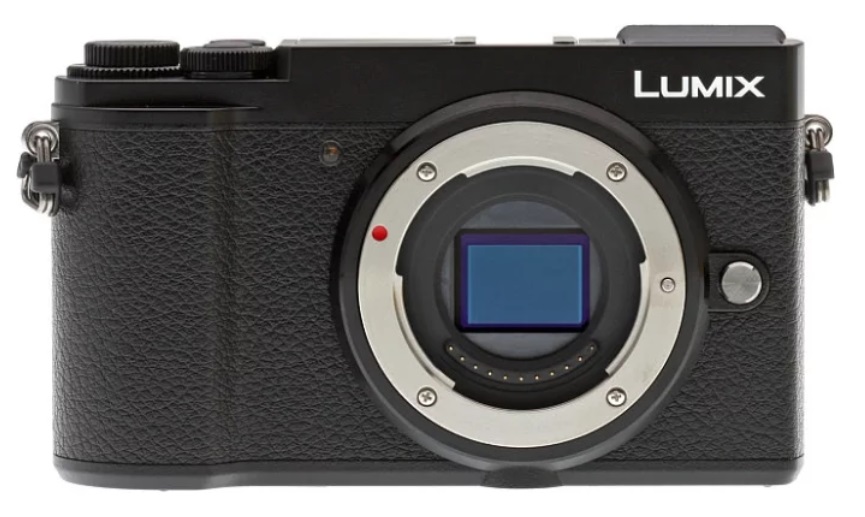
The camera supports SD memory cards as well as SDHC and SDXC cards.
Available interfaces USB 2.0, HDMI, Bluetooth.
The device is equipped with one battery of its own, which is enough for 260 photos in standard mode.
The camera is designed to create AVCHD and MP4 videos at sixty frames per second.
Advantages:
- cleaning the sensor;
- built-in flash that eliminates red-eye.
- optical stabilizer with sensor shift;
- timer (10 s);
- with Time-lapse mode;
- with autofocus illumination;
- with manual focus;
- with focus on the face;
- with recording mode "JPEG + RAW";
- supports Wi-Fi technology;
- additional functionality.
Disadvantages:
- no lens included;
- low speed of photography.
Fujifilm X-A10 Kit
Manufacturer: Fujifilm (Japan)
The average price is 26,000 rubles.
A mirrorless camera without a viewfinder and with support for interchangeable Fujifilm X Mount lenses. The number of effective pixel sensor (CMOS size 23.6x15.6 mm) is 16.3 million. Crop factor is 1.
You can choose the white balance yourself or trust the automatic settings. Bracketing can be used if necessary.
The flash, built into the structure, has a range of up to five meters.
The device allows you to take six frames per second and the maximum number of photos in a burst is twenty in the JPEG standard, but RAW is also available for saving in standard mode. Available formats are 3: 2, 1: 1, 16: 9.
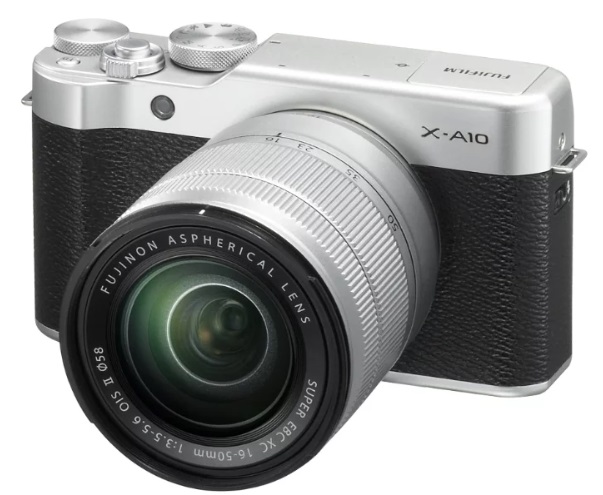
The 3-inch LCD has a swivel mechanism. Contrast autofocus with 49 focusing points and focus on the face.
Suitable memory cards for SD format and its extensions. Interfaces - USB 2.0 and HDMI, there is also a remote control connector.
The camera is equipped with its own battery in the amount of 1 piece, which is enough for 410 standard shots.
Allows you to record video with sound in the MOV standard with a maximum resolution of 1920 × 1080 and a frequency of 50 frames per second.
Equipped with a mount that allows you to mount the camera on a tripod. The package includes, in addition to the battery, an AC adapter, a power plug adapter, a USB cable and a shoulder strap.
Advantages:
- lens included;
- with sensor cleaning function;
- high image quality;
- flash with red-eye reduction;
- there is a timer;
- with Time-lapse mode;
- using the screen as a viewfinder;
- with manual adjustment of shutter speed and aperture;
- with exposure bracketing;
- with autofocus illumination and manual focus;
- with JPEG + RAW recording mode;
- supports Wi-Fi;
- HD shooting;
- additional equipment.
Disadvantages:
- without stabilizer;
- low speed of photography;
- without a touchscreen;
- insufficient screen detail.
Tips: choosing the best

There are many models on the market, from the variety of which it is easy to get confused. There are not so many universal tips, but if you summarize the customer reviews, you can draw the following conclusions:
- You shouldn't go to the store without choosing a specific camera model and counting on the help of sellers. Firstly, the staff is not always competent, and secondly, they may be guided by their own interests, and not the interests of the buyer.
- Before buying it will not be superfluous to familiarize yourself with the review on the camera. There are a great many publications on the Web, as well as videos, containing a description of this or that equipment. This will help you make a comparison between different models and make a choice in favor of the appropriate option.
- Features such as Wi-Fi, NFC, GPS increase the cost of the device, and not everyone desperately needs them.
- In some models of modern cameras, video recording is carried out in 4K format, one for viewing such video recording will also require a 4K TV resolution. You can also use a similar projector or monitor. But remember that a good movie can also be shot with the Full HD function.
- The manufacturer is important, but you should not get hung up on a particular company. The popularity of models of certain brands is determined not so much by the technical advantage of the device itself as by the popularity of the brand. Every firm can boast of both successful product lines and failures.
Which company is better?
The best manufacturers of modern cameras are electronics giants hailing from Japan:
- Panasonic;
- Fujifilm;
- Sony;
- Canon;
- Nikon.
Popular models are also produced by Pentax and Sigma (Japan), Samsung (South Korea), Hasselblad (Sweden), Leica (Germany).
If you have experience using mirrorless cameras described in the rating, or a more interesting model, tell us about it in the comments.












